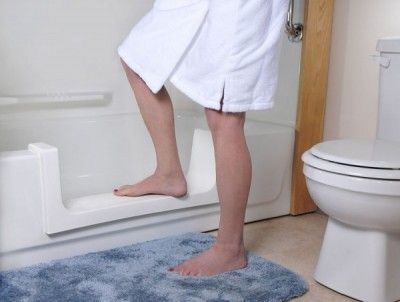Certified Aging in Place Specialist Series- Scott Anderson
As you age, it's important to make changes to your home to ensure it's safe and functional. Learn about the most important factors to consider when planning to age in place, including bathroom safety and home modifications. Get tips and recommendations from a CAPS professional.

Diane: Scott, my goal is to help aging individuals make their home their partner as they age. Can you tell me when is a good time to begin to make changes in the home?
Scott: The most important step is… to gather a team of individuals to get feedback from all the important players. In addition to the aging seniors and their spouses, adult children, primary caregivers and medical professionals (Occupational therapist, physical therapist, home care worker, physician, etc.). The CAPS professional appreciates feedback from all in the decision making process.
The process is:
- Establish the Team, as mentioned above
- 2 Assess the senior’s needs and present functional ability. Discuss with family members and medical professional… potential future health care needs or concerns.
- Assess the home;
- Propose home modifications with cost and timetable
- Finance
- Construction Phase
- Apply the warranty
Diane: Can you make some inexpensive recommendations … that may be helpful to any aging senior now?
Scott: We offer ideas that range from replacing a white electric plate on a white wall with a new $.50 dark brown one… so a senior with vision problems can find their switches and plugs. To installing a $40K elevator or adding a new $80K master suite to a home.
Tips to Help Seniors Age in Place
There are many free and inexpensive changes that seniors can do to make their home work better for them. Most, of course, depend on their particular need.
- Throw rugs should be removed or taped down.
- Storm/screen doors should be removed.
- Closet doors can be removed.
- Shower doors should be replaced with curtains.
- Higher wattage light bulbs can improve effective vision.
- Add railings on the 2nd side of stairs or along hallways.
- Replace a stationary shower head with a hand-held hose.
- Add a seat in a shower.
- Replace door knobs, cabinet pulls, and faucet handles with levers.
Diane: What are the most important factors an aging senior should consider … when planning to age in place?
Scott: Act sooner rather than later. Contact a CAPS professional soon. Concentrate on listing the difficulties you’re having. Let the CAPS designer help figure out the solutions.
Once we understand the senior’s abilities, we can design to those specific strengths. We virtually always can see solutions that the family does not. In fact, we often see pitfalls that the family does not.
CAPS contractors operate with different business models. Our company, Trivest Construction, is willing to advance all services up to the # 6 step the Construction Phase . This is without any obligation by the senior.
Only when they accept our construction proposal are they obligated to us. That’s after all the modifications have been identified, priced, and scheduled. We seldom lose a client once the proposal is created.
Diane: The bathroom is where most of these falls occur. What recommendations can you make to make a bathroom safe for the aging senior?
Fall Prevention Strategies for Aging in Place
Scott: Use a “comfort height” toilet. Foot operated flusher are available.
Add grab bars next to the toilet. Though there are standard grab bar locations, the pattern for each specific senior should be customized (type, location, size, spacing, number, etc.).
Utilize a shower seat.
Use shower curtains rather than shower doors. Change a standard shower head to a hand held head as appropriate.
A scald guard is also important for the very young and as we age.
Shower grab bars are an important safety measure.
Install a non slip bathroom floor.
Consider installing a roll-in shower system. This is for anyone in a wheelchair or if you anticipate that an individual may use a wheelchair in the future.
A roll in shower system should also be considered. This is for individuals with severe arthritis, or have chronic conditions that may affect… walking or balance in the future.
Change vanity for wheelchair (knee space, counter height, shallow sink, faucet location, etc). Add a pivot vanity mirror for a wheelchair.
Improve lighting. Locate electric switches and plugs in more convenient spots.
Utilize lever handles on all faucets. Install
Consider an emergency call button or personal emergency response system.
Bathroom Safety for Aging in Place
Diane: I always feel that for every problem there is a solution. Does this apply to making changes in the home using Universal design principles?
Scott: I don’t believe that all houses can be equipped to safely accommodate all clients . That is unless there are no supplemental staffing limits (doesn’t happen in real life).
We do our best to equip the house as appropriate. I think the “universal” design term applies to general accommodations that are good for all of us (shallow threshold, tall toilet, wide doorways, lever handles, main floor full bath and bedroom, lower switches, higher duplex receptacles, etc.).
Most of the work we do goes well beyond ”universal” features. We do work to accommodate very specific problems that our clients experience.
For instance, if they have vision problems… we add better general lighting… task lighting… closet lighting and stairway edge stripes… Counter edge color contrast, etc.
I don’t consider these universal design considerations.
We listen to professionals that manage the care of our client. We’re anxious to accommodate the client at home; but that isn’t always the best solution. Trivest Construction has done extensive work within assisted living facilities. We accommodate specific needs of our clients, who live in those apartments.
We install additional grab bars… improve lighting… paint the walls “home bedroom pink” etc. to make their apartment work better for them.
Diane: Can you share your favorite new product or any new products that would benefit the readers in the future?
Scott: I attend several professional conferences each year to keep up with available products.
In 2009, I attended or will attend the:
- International Builders Show in Las Vegas
- The Remodeler Show in Indianapolis
- The Kitchen and Bath Industry Show in Atlanta
- Medtrade in Atlanta
- The World Congress on Disabilities in Jacksonville
- The Southern Building Show in Atlanta
- Southeast Building Conference in Orlando.
It’s important to keep up.
When I present to groups, the most interesting response is when I suggest changing the color of electrical plates. Like the ones I described above. When I suggest adding a $50 flat shelf near the front door to set your purse or package while you search for your keys.
Diane: Can you share stories and photos of utilizing universal design in an established home? One that assisted your client to remain in their present home environment?
Scott: I have a bunch! We do a pretty good job of documenting our projects with ”before”, “during”, and “after” photos.
Diane: Thank you Scott. For offering advice to my readers about home accessibility modifications. And other solutions that will encourage successful aging in place.
Exterior Home Ideas for Aging In Place
Certified Aging in Place Specialist: Enhancing Independent Living for Seniors
Discover the Benefits of Hiring a Certified Aging-in-Place Specialist
Are you a senior who wants to continue living in the comfort of your own home? You're not alone. The CDC defines aging in place as the ability to live independently and safely in your own home, regardless of age or ability level. It's a popular choice, with 76% of Americans aged 50 and older expressing a desire to stay in their current homes for as long as possible.
However, before you can make this a reality, there are important considerations to take into account. One of the main factors is whether your home is currently suitable for aging in place.
For many individuals, the answer is no. In fact, a 2018 survey by AARP found that 63% of seniors anticipated the need for home modifications to accommodate their desire to age in place.
This is where a certified aging-in-place specialist (CAPS) comes in. These professionals are trained to assess your home and make the necessary modifications to ensure you can continue living independently and safely. They understand the unique needs of the aging population and have the expertise to create barrier-free living spaces.
With the help of a CAPS, you can make modifications such as installing grab bars, adding handrails, and implementing non-slip measures. They can also assist with larger modifications, such as widening doorways or constructing ramps for wheelchair accessibility.
Additionally, CAPS can provide guidance on low-maintenance landscaping, interior finishes, and adjusting kitchen appliances for ease of use. Their goal is to help you create a home that meets your specific functional needs and allows you to age gracefully.
If you're considering aging in place, now is the time to take action. By proactively working with a CAPS, you can plan and budget for modifications before they become urgent. Start by asking the right questions and researching reputable contractors.
Don't let the challenges of aging in place deter you from the independence and comfort of home. Reach out to a certified aging-in-place specialist today to start enhancing your living environment.
You might also like this article:





